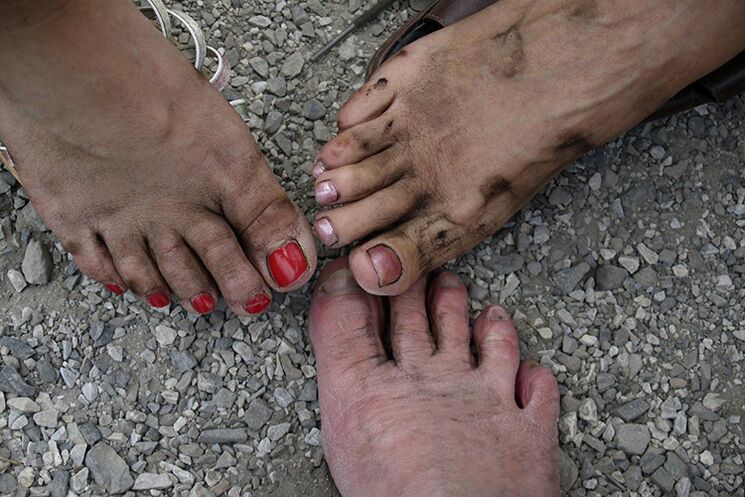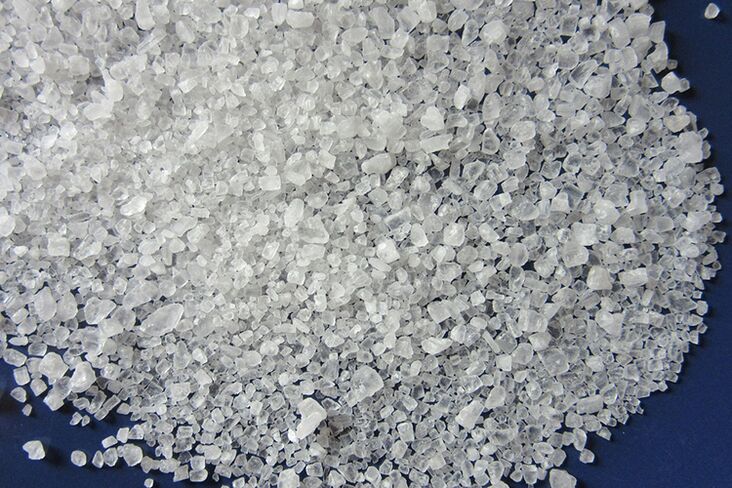Dermatophytosis is a common group of diseases. Patients do not always take them seriously, which leads to advanced forms of the disease that are difficult to treat. Fortunately, there are many ways to get rid of a fungal infection in your feet and get rid of an unpleasant disease like fungal infections of your toes and feet.
Patients do not always take them seriously, which leads to advanced forms of the disease that are difficult to treat. Fortunately, there are many ways to get rid of a fungal infection in your feet and get rid of an unpleasant disease like fungal infections of your toes and feet.
Ringworm between the fingers - how does the disease progress?
Dermatophytosis is an infectious disease caused by a fungus parasitic on the skin. They can appear anywhere on the body. But more often than not, they choose skin folds. The space between the toes is their favorite place. That's because feet often sweat, wearing tight shoes, moisture does not have time to evaporate. Therefore, the spaces between the fingers are often wet. And these conditions are just what the fungus needs to reproduce. It is not uncommon for the fungus to enter the indentations between the fingers from an infected nail.
Contributes to the development of skin diseases:
- inadequate foot hygiene, overheated feet or hypothermia;
- tendency to increased sweating;
- poor blood circulation in the feet related to heart disease, smoking, diabetes;
- emphasize;
- calluses and cuts on the skin of the legs;
- lack of vitamins and minerals (mainly zinc) in the body;
- trophic ulcers on the legs;
- hormonal imbalance and thyroid disease;
- overweight;
- excessively dry skin.
However, in most cases, fungus between the toes does not develop if the person has a healthy immune system.
The disease is common in men, due to often wearing tight shoes. Fungus on the feet can not only appear in adults but can also appear in children.
Ringworm between the toes in 90% of cases is caused by the action of three fungi belonging to the dermatological group - Trichophyton, Microsporum, Epidermophyton. In addition, often the skin in the spacers is affected by fungi of the genus Candida.
Usually, the initial infection develops in the space between the two smallest toes. However, other digit spaces may also be affected. Once on the skin, the fungus will actively multiply on it. The rest of the stratum corneum of the skin serves as food for microorganisms.
Skin infections can be spread from person to person. For this, a simple contact of the skin of the feet with surfaces containing the fungus is enough. Transmission of germs can happen when others wear shoes, socks, share towels, and wet floors in the bathroom. Need to carefully monitor personal hygiene, only sharing personal items. In pools, showers, baths and saunas, personal or disposable slippers and flip flops are recommended.

Usually, skin diseases are passed from one family member to another, sharing items such as shoes, toenails, socks, towels, walking around the house barefoot, etc. v.
Symptoms of a fungal infection on the skin of the feet.
Symptoms of foot fungus in the early stages:
- itching and burning, worse at night;
- dry;
- skin peeling;
- small cracks.
As the disease progresses, the symptoms become more and more severe, itchy and uncomfortable, leading to the condition of the skin being scratched, irritated, and deeper and deeper cracks. The skin of the feet becomes rough. Appearance of acne spots, unpleasant odor that does not go away even after washing, edema and congestion, peeling of the epidermis.
Then appear bubbles filled with serous fluid. After opening them, non-healing festering sores remain on the skin. A type of bacteria involved in mycotic infections.
Nails are peeling, there may be abscesses. A complication of athlete's foot can be the entry of the fungus into the bloodstream and its spread throughout the body. At the same time, body temperature rises. Venous lesions in the feet may also develop. Cardiovascular diseases, immunocompromised states, and diabetes further complicate the course of skin disease.
To diagnose tinea pedis, your doctor may not be enough to examine the skin. Often it is necessary to analyze the composition of the microflora of the skin. For this, a scrape is taken from the affected surface. Fungi can be found on the skin even when there are no obvious symptoms of infection.
There is also a common method for determining the presence of fungus on the feet. To do this, you need to put your feet in a bath containing potassium permanganate. If there is no fungus on the skin, then it will turn pink, and the infected areas will turn white.
How to remove fungus between toes?
Infection on the skin is easy, but getting rid of it is much more difficult. Skin mycoses are always treated at home, but this does not mean that the patient will definitely be helped by completely independent treatment. In all cases, it is necessary to consult a doctor.
There are many antifungal drugs that effectively kill the fungus. However, the success of treatment largely depends on the stage of the disease. If she has gone too far, it will be difficult to get rid of the infection. At the initial stage, external antifungal drugs are used. If the disease has already developed, then doctors recommend treatment with systemic measures. Usually, terbinafine, itraconazole, fluconazole are prescribed in tablet form.
Common antifungal agents:
- nystatin,
- fluconazole,
- ketoconazole,
- clotrimazole,
- terbinafine,
- naftifine,
- miconazole,
- itraconazole,
- natamycin.
Some antifungal ointments also contain anti-inflammatory ingredients.
The method of application of all ointments is the same - they must be regularly applied to the affected skin areas with a thin layer. Some ointments are sufficient for once-daily use, others require more frequent use. Antifungal sprays that can be sprayed on the affected area are even more convenient than ointments.
Treatment with antifungal ointments can be prolonged. Some ointments clear the infection after 2 weeks. But with severe lesions, the treatment time can last up to 3 months. Doctors recommend applying the ointment at least 2 weeks after the obvious symptoms of the disease have passed. And every six months it is necessary to lubricate the toes with ointment for prevention.
In addition, for severe infections, systemic antifungal drugs can be used. However, they have a long list of contraindications and side effects. In particular, oral antifungal tablets are contraindicated for pregnant women. In addition, many topical ointments are prohibited during pregnancy. If there is a need to use such topical preparations, it is necessary to consult a doctor. Not all drugs are allowed in childhood. Therefore, you need to see the instructions for the selected tool. Some drugs can be used from 2 years of age, others from 12 years of age.
The specialist should choose the right drug. Improper use of antipyretics not only does not reduce the patient's pathogenic microorganisms, but also can lead to drug resistance in the patient (especially in the condition that the patient is frequently re-infected). Toxins secreted by many fungi suppress local immunity, which further contributes to the development of infection.
In addition, vitamin and mineral complexes are taken. If the disease is complicated by a bacterial superinfection, the doctor will prescribe antibiotics, but if there are allergic manifestations, prescribe an antihistamine. Treatment can be supplemented with anti-inflammatory ointments, salicylic, sulfuric, ichthyol and zinc ointments.
Salicylic ointment:
- has disinfecting properties,
- prevent keratinization of the skin,
- promotes the recovery of the epidermis,
- prevent the spread of infection.
Zinc ointment contains lanolin, menthol, zinc oxide. Zinc ointment has antiseptic properties, promotes skin regeneration, relieves itching and burning.
Sulfur ointment has anti-inflammatory, emollient and antiseptic properties. Ointment Ichthyol has anti-keratinic, anti-inflammatory, and bactericidal effects. In addition, ichthyol ointment promotes tissue regeneration.
Don't forget to clean your feet. It is necessary to give up tight, uncomfortable shoes, synthetic socks and socks, and change the lining often. Shoes must be disinfected with an anti-shrink spray. Indeed, the treatment won't work if the patient's skin is constantly infected with new parts of the fungus that lives in the shoes.
Fungus between the toes: Treatment with folk remedies at home
Treatment with pharmaceutical preparations does not always bring the desired effect. So people look to folk remedies. This is understandable since many synthetic antispasmodic ointments and sprays are not cheap. Treatment with folk remedies can be taken as an adjunct to treatment with a pharmacy topical ointment.
The simplest folk remedies for getting rid of fungus are salt and soda baths. To prepare the tray, you will need 2-3 tablespoons of salt or soda per 5 liters. Country. Water temperature - + 40-45 ° C. The duration of the procedure is 15-20 minutes.

One of the best home remedies is herbal baths with antiseptic properties. It can be chamomile, sage, calendula, nettle, St. John. To prepare a bath, you need 2-3 tbsp. Plant ingredients (you can get a mixture of various herbs) put in a cup of boiling water, filter and put in a 5-liter bucket with water for bathing. The water should be warm but not burn the skin of the feet. The duration of the procedure is 15-20 minutes.
Many people who have fungus on the skin of their feet are also bathed with a purple solution. To make a light pink solution, only a few beads of potassium permanganate are needed. You can also moisten cotton balls with a solution of potassium permanganate and stick them between your fingers.
Boric acid also has a therapeutic effect. You can use both liquid and powdered boric acid. Acid can be added to the bath and treated with the affected area.
For the tray, you can also use a slightly warm 9% apple cider vinegar solution. The duration of the procedure is 15 minutes. You can also make lotion with vinegar.
Another recipe is an iodine bath. To prepare the solution, it is enough to dilute only 20 drops in 3 liters of warm water. Time to perform 15 minutes, treatment 2-3 weeks.
After finishing the hydration procedure, it is necessary to clean the skin from keratinized and flaking tissues. It is recommended to shower at least once a day, preferably at night.
In addition, to treat foot fungus, you can use ointments with garlic, pharmacy dandruff shampoos with antifungal ingredients, lotions with chlorhexidine and hydrogen peroxide.
Prevention of fungal infections of the toes
This disease occurs due to non-compliance with the rules of personal hygiene. Therefore, it is necessary to:
- do not use other people's pedicure tools, towels, slippers, socks, shoes, do not allow strangers to use their own shoes, socks, hygiene items;
- compliance with foot hygiene, daily washing of the skin with soap, careful treatment of the toes;
- regular toenail trimming;
- wear comfortable shoes and socks made of breathable fabric;
- regularly change socks, wear socks that are washed at a temperature of at least + 40 ° С;
- Exercise to improve blood circulation in your legs.
What is the fastest treatment?
It is impossible to say with certainty which remedy is the fastest and best. After all, the effectiveness of therapy for mycosis fungoides depends on many cases - the severity of the pathology, the degree of immunity, the presence of concomitant diseases. Some patients are helped by traditional methods, others - by pharmaceutical ointments. It is important not to start the illness and start treatment at the first sign of it. Identifying the type of pathogen is also important. To do this, you need to see a doctor. Perhaps he will be able to find the best option for the drug.


























